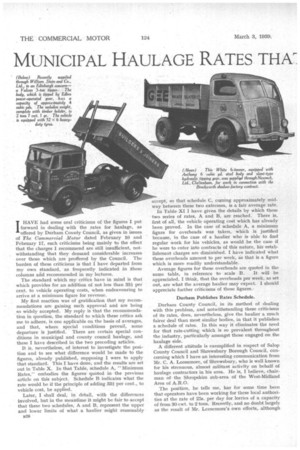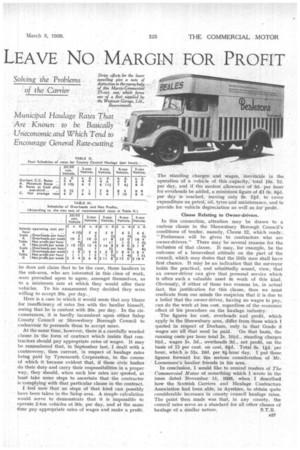MUNICIPAL HAULAGE RATES THA'
Page 36

Page 37

If you've noticed an error in this article please click here to report it so we can fix it.
LEAVE No MARGIN FOR PROFIT IHAVE had some oral criticisms of the figures I put forward in dealing with the rates for haulage, as offered by Durham County Council, as given in issues of The Commercial Motor dated February 10 and February 17, such criticisms being mainly to the effect that the charges I recommend are still insufficient, notwithstanding that they demand considerable increases over those which are proffered by the Council. The burden of these criticisms is that I have departed from my own standard, as frequently indicated in these columns and recommended in my lectures.
The standard which my critics have in mind is that which provides for an addition of not less than 331 per cent. to vehicle operating cos, when endeavouring to arrive at a minimum figure for revenue.
My first reaction was of gratification that my recommendations are gaining such approval and are being an widely accepted. My reply is that the recommendation in question, the standard to which these critics ask me to adhere, is one applicable on the basis of averages, and that, where special conditions prevail, some departure is justified. There are certain special conditions in municipal and county council haulage, and these I have described in the two preceding articles.
It is, nevertheless, of interest to investigate the position and to see what difference would be made to the figures, already published, supposing I were to apply that standard. This I have done, and the results are set out in Table X. In that Table, schedule A, "Minimum Rates," embodies the figures quoted in the previous article on this subject. Schedule B indicates what the rate would be if the principle of adding 331 per cent., to vehicle cost, be applied.
Later, I shall deal, in detail, with the differences involved, but in the meantime it might be fair to accept that these two schedules, A and B, represent the upper and lower limits of what a haulier might reasonably accept, so that schedule C, coining approximately midway between these two extremes, is a fair average rate.
In Table XI I have given the details by which these two series of rates, A and B, are reached. There is, first of all, the vehicle operating cost which has already been proved. In the case of schedule A, a minimum figure for overheads was taken, which is justified because,. in the case of a haulier who is able to find regular work for his vehicles, as would be the case if he were to enter into contracts of this nature, his establishment charges are diminished. I have indicated What these overheads amount to per week, as that is a figure which is more readily understandable.
Average figures for these overheads are quoted in the same table, in reference to scale B. It will be appreciated. I think, that the overheads per week, as set out, are what the average haulier may expect. I should appreciate further criticisms of these figures.
Durham Publishes Rates Schedule.
Durham County Council, in its method of dealing with this problem, and notwithstanding these criticisms of its rates, does, nevertheless, give the haulier a much fairer deal than most similar bodies, in that it publishes a schedule of rates. In this way it eliminates the need for that rate-cutting which is so prevalent throughout the industry, particularly amongst those engaged on the haulage side.
A different attitude is exemplified in respect of Salop County Council and Shrewsbury Borough Council, concerning which I have an interesting communication from Mr. C. A. Loosemore, of Shrewsbury, who is well known for his strenuous, almost militant activity on behalf of haulage contractors in his area. He is, I believe, chairman ofthe Shropshire sub-area of the West-Midland Area of A.R.O.
The position, he tells me, has for some time been that operators have been working for these local authorities at the rate of 25s. per day for lorries of a capacity of from 30 cwt. to 2 tons. Recently, and no doubt largely as the result of Mr. Loosemore's own efforts, although he does not claim that to be the case, those hauliers in the sub-area, who are interested in this class of work, were prevailed upon to agree, amongst themselves, as to a minimum rate at which they would offer their vehicles. To his amazement they decided they were willing to accept 30s. per day..
Here is a case in which it would seem that any blame for insufficiency of rates lies with the haulier himself, seeing that he is content with 30s. per day. In the ciircumstances, it is hardly incumbent upon either Salop County Council or Shrewsbury Borough Council to endeavour to persuade them to accept more.
At the same time, however, there is a carefully worded clause in the form of contract which insists that contractors should pay appropriate rates of wages. It may be remembered that, in September last, I dealt with a controversy, then current, in respect of haulage rates being paid by Tynernouth Corporation, in the course of which it became evident that, if these civic bodies do their duty and carry their responsibilities in a proper way, they should, when such low rates are quoted, at least take some steps to ascertain that the contractor is complyingwith that particular clause in the contract.
I feel sure that no steps of that kind can possibly
• have been taken in the Salop area. A simple calculation would serve to demonstrate that it is impossible to operate 2-ton vehicles at 30s. per day, and at the same time pay appropriate rates of wages and make a profit. The standing charges and wages, inevitable in the operation of a vehicle of this .capacity, total 18s. 7d. per day, and if the modest allowance of 3d. per hour for overheads be added, a minimum figure of 21 Os. 80. per day is reached, leaving only 9s. Sid. to cover expenditure on petrol, oil, tyres and maintenance, and to provide for vehicle depreciation as well as for profit.
Clause Relating to Owner-drivers.
In this connection, attention may be drawn to a curious clause in the Shrewsbury Borough Council's conditions of tender, namely, Clause 12, which reads: "Preference will be given to contractors who are owner-drivers." There may be several reasons for the inclusion of that clause. It may, for example, be the outcome of a benevolent attitude on the part of the council, which may desire that the little man shall have first chance. It may be an indication that the surveyor holds the practical, and admittedly sound, view, that an owner-driver can give that personal service which is often such a valuable asset in work of this kind. Obviously, if either of these two reasons be, in actual fact, the justification for this clause, then we must eradicate from our minds the suspicion that it is due to a belief that the owner-driver, having no wages to pay, can do the work at less cost, regardless of the economic effect of his procedure on the haulage industry.
The figures for cost, overheads and profit, which apply in the Shrewsbury area, differ from those which I quoted in respect of Durham, only in that Grade 3 wages are all that need be paid. On that basis, the running costs per hour total 2s. 104c1., standing charges 91d., wages is. 5d., overheads 3d., net profit, on the basis of 15 per cent. on cost, 9-id. Total 6s. lid. per • hour, which is 51s. 10d, per 8i-hour day. I put these figures forward for the serious consideration of Mr. Loosemore's haulier friends in his area.
In conclusion, I would like to remind readers of The Commercial Motor of something which I wrote in the issue dated November 11, 1938, when I described how the Scottish Carriers and Haulage Contractors Association had been able, in Ayrshire, to obtain quite considerable increases in county council haulage rates. The point then, made was that, in any county, the council rates serve as a standard for all other classes of
haulage of a similar nature. S.T.R.




















































































